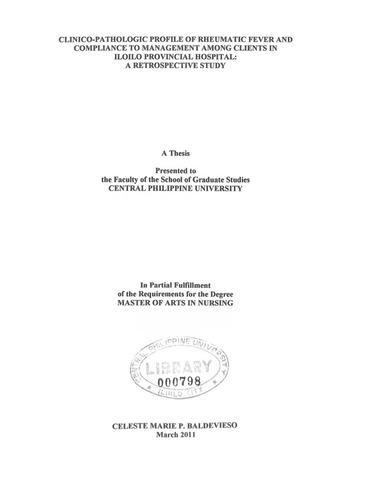Clinico-pathologic profile of rheumatic fever and compliance to management among clients in Iloilo Provincial Hospital: A retrospective study
| dc.contributor.adviser | David, Fely P. | |
| dc.contributor.author | Baldevieso, Celeste Marie P. | |
| dc.date.accessioned | 2021-02-11T05:37:34Z | |
| dc.date.available | 2021-02-11T05:37:34Z | |
| dc.date.issued | 2011 | |
| dc.identifier.citation | Baldevieso, C. M. P. (2011). Clinico-pathologic profile of rheumatic fever and compliance to management among clients in Iloilo Provincial Hospital: A retrospective study (2011). Central Philippine University, Jaro, Iloilo City. | en_US |
| dc.identifier.uri | https://hdl.handle.net/20.500.12852/288 | |
| dc.description | Abstract only | en_US |
| dc.description.abstract | This study was conducted to determine the clinico-pathologic profile of rheumatic fever and its relationship with medical treatment compliance among clients in Iloilo Provincial Hospital using a retrospective study design. Total enumeration of clients yielded 103 eligible subjects. With the checklist as a guide, document review was used for data collection. Results of the study revealed that the mean age of the subjects was 13.4 years old, with the majority being less than 13 years old. Majority of the subjects were females, lived seven kilometers or less from the hospital, and had been under treatment for more than two years. A high proportion of the subjects did not have coexisting conditions. Most clients had a combination of major and minor clinical presentations, commonly exhibiting fever and carditis. Majority of the clients were compliant to laboratory exams. A high proportion of clients were partially compliant with antibiotic treatment. When taking both treatment categories as a whole, the clients had an average level of compliance. The statistical tools used to determine the presence of association and relationship were ChiSquare, Fisher’s Exact Test, and Cramer’s V set at 95 percent confidence level. Analysis of data revealed that coexisting condition was moderately associated with the clinical presentation of rheumatic fever. The coexisting condition was also strongly associated with laboratory and diagnostic exam compliance, while the duration of treatment was strongly associated with antibiotic treatment compliance. Clinical presentation had a positive but weak relationship with laboratory and diagnostic exam compliance, but the clinical presentation had no relationship with antibiotic treatment compliance. The researcher concludes that the majority of the clients were females, living near the hospital, with more than two years of medical treatment, and were not experiencing coexisting health conditions. Carditis was the most common major clinical feature, while fever was the most frequent minor clinical feature presented. Generally, the clients were compliant with prescribed medical management. The presence of coexisting conditions that pose greater health threats can serve as good predictors of clinical presentation of rheumatic fever. Further, it can also encourage compliance to laboratory and diagnostic examinations. A longer treatment period increases patients’ compliance with antibiotic treatment. The presence of more severe or threatening clinical presentation of rheumatic fever encourages laboratory and diagnostic examination compliance but not compliance to antibiotic treatment. | en_US |
| dc.format.extent | v, 77 leaves | en_US |
| dc.language.iso | en | en_US |
| dc.subject.ddc | GSL Theses 610.73072 B192 | en_US |
| dc.subject.lcsh | Carditis | en_US |
| dc.subject.mesh | Rheumatic Fever | en_US |
| dc.subject.mesh | Fever | en_US |
| dc.title | Clinico-pathologic profile of rheumatic fever and compliance to management among clients in Iloilo Provincial Hospital: A retrospective study | en_US |
| dc.type | Thesis | en_US |
| dc.description.bibliographicalreferences | Includes bibliographic references | en_US |
| dc.contributor.chair | Yoro, Carolyn L. | |
| dc.contributor.committeemember | Delicana, Lilia A. | |
| dc.contributor.committeemember | Lamasan, Nelida L. | |
| dc.contributor.committeemember | Peñaflor, Mae Joy B. | |
| dc.contributor.department | School of Graduate Studies | en_US |
| dc.description.degree | Master of Arts in Nursing | en_US |


